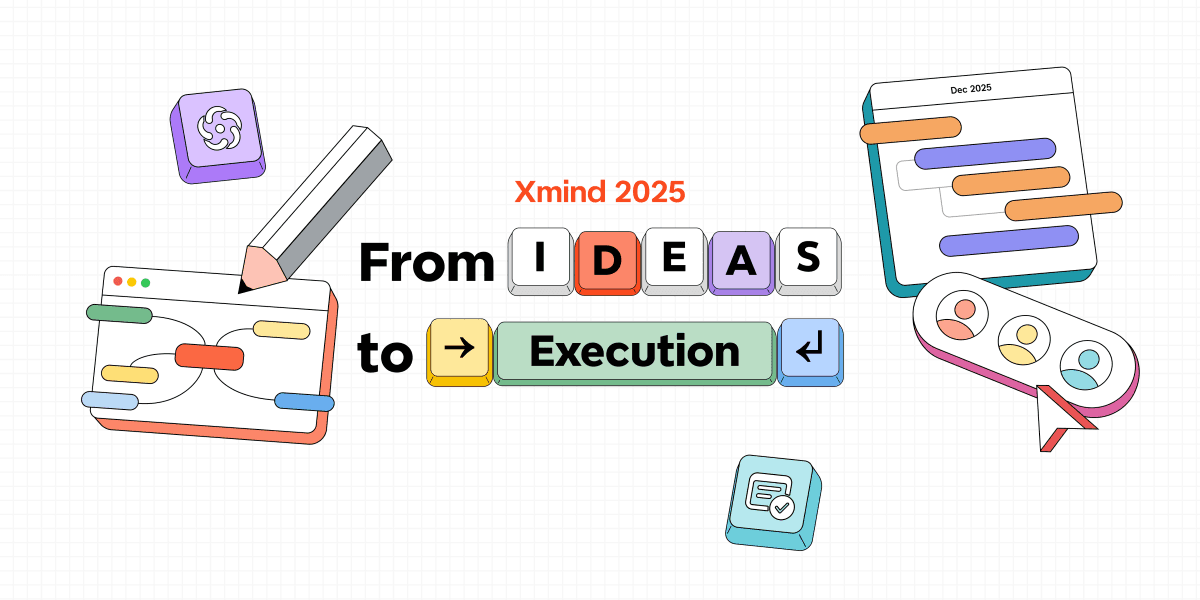18 сент. 2025 г.
Понимание структуры разделения работы (WBS): Полное руководство
В сфере управления проектами Структура декомпозиции работ (SDR) является важным инструментом, который помогает командам справляться с сложностями их проектов. Разделяя крупные задачи на управляемые компоненты, SDR не только проясняет объем работ, но также помогает в планировании, бюджете и распределении ресурсов. Эта статья рассматривает сложности SDR, ее типы, преимущества и как эффективно внедрить ее в своих проектах.
Хотите легко визуализировать свою SDR? Попробуйте создать его с помощью Xmind, удобного инструмента для создания карт ума, который превращает сложные планы проектов в четкие, управляемые диаграммы.
Что такое Структура декомпозиции работ?
Структура декомпозиции работ — это иерархическая декомпозиция проекта на более мелкие, управляемые части. Она служит визуальным представлением объема работ проекта, позволяя менеджерам четко обозначить результаты и задачи. SDR необходима для обеспечения охвата всех аспектов проекта: от высокоуровневых целей до конкретных задач.
Основные компоненты SDR
Фазы: Основные этапы жизненного цикла проекта.
Задачи: Индивидуальные действия внутри каждой фазы.
Подзадачи: Более мелкие задачи, входящие в каждую главную задачу.
Результаты: Осязаемые или неосязаемые выходы, полученные в результате завершенных задач.
Пакеты работ: Наименьшие единицы работы, которые можно назначить членам команды.
Организация этих компонентов обеспечивает ясность и структуру, что упрощает эффективное управление проектом.
Важность SDR в управлении проектами
Внедрение SDR важно по нескольким причинам:
Ясность: Помогает определить объем проекта, гарантируя, что все члены команды понимают свои роли и обязанности.
Распределение ресурсов: Разбивая задачи, менеджеры могут лучше распределять ресурсы и оценивать затраты.
Управление рисками: Идентификация задач позволяет оценить потенциальные риски, связанные с каждым компонентом.
Отслеживание прогресса: Хорошо структурированная SDR позволяет командам мониторить прогресс и вносить необходимые корректировки.
В сущности, SDR действует как путеводитель, направляя команды через жизненный цикл проекта и минимизируя путаницу и недопонимание.
Типы Структуры декомпозиции работ [с шаблонами]
Существует множество подходов к структурированию SDR, каждый из которых служит различным потребностям проекта. Два самых распространенных типа:
Пример SDR, основанной на результатах
Этот тип акцентирует внимание на том, что проект должен произвести. Например, в проекте по редизайну сайта основными результатами могут быть Пользовательский интерфейс, Разработка серверной части и Миграция контента. Каждый результат затем разбивается на более мелкие результаты, задачи и пакеты работ. Такой подход лучше всего подходит, когда конечный продукт ясен.

Пример фазовой SDR
Вместо сосредоточения на выходах, фазовая SDR выделяет когда происходит работа. Например, строительный проект может быть разбит на Этап проектирования, Этап фундамента, Этап строительства и Этап завершения. Каждый этап затем подразделяется на задачи и подзадачи. Этот метод подходит для проектов с четко выраженными хронологическими этапами.

Организационная SDR (OBS)
Организационная структура декомпозиции (OBS) связывает проектные результаты с конкретными отделами или командами. Например, в запуске продукта отдел Маркетинга может заниматься Планированием кампании, Инженерный отдел сосредотачивается на Разработке функций, а отдел Поддержки клиентов управляет Документацией помощи. Это обеспечивает четкую ответственность и согласование между пакетами работ и организационными единицами.

Географическая или структурированная по местоположению SDR
Для крупномасштабных или распределенных проектов SDR может быть структурирована по местоположению. Например, глобальный проект расширения может быть разделен на регионы Северная Америка, Европа и Азиатско-Тихоокеанский регион. В каждом регионе задачи, такие как Регулирование соответствия, Местный набор и Исследование рынка, далее разбиваются. Этот метод распространен в строительстве, логистике или транснациональных инициативах.
Создание эффективной SDR: пошаговое руководство
Структура декомпозиции работ (SDR) — это не просто диаграмма; это основа планирования, графика и контроля вашего проекта. Создание эффективной SDR требует баланса: детализация должна быть достаточной для ведения работ, но не настолько подробной, чтобы стать излишне сложной. Ниже приведен структурированный шестишаговый процесс разработки практичной и полезной SDR.
Шаг 1: определение объема и целей проекта
Первый шаг закладывает основу. SDR без хорошо определенного объема рискует стать либо незавершенной, либо чрезмерно сложной.
Сильное заявление об объеме должно:
Улавливать конечную цель проекта (как выглядит успех).
Четко идентифицировать границы (что входит в объем и что нет).
Устанавливать измеримые результаты, которые будут служить контрольными точками.
Например, в проекте запуска нового веб-сайта объем может включать «публичный сайт с возможностью электронной коммерции», при этом явно исключая «послезапусковую поддержку клиентов». Эта ясность позволяет вашей SDR соответствовать организационным приоритетам и помогает предотвратить расширение объема позже.
Шаг 2: идентификация основных результатов
Результаты — это строительные блоки вашей SDR. Они представляют выходы, необходимые для выполнения объема проекта. Это не действия, а конечные результаты.
Думайте о результатах как о узлах первого уровня в вашей SDR. Для мобильного банковского приложения они могут быть:
Дизайн пользовательского интерфейса
Интеграция серверной части
Тестирование безопасности
Инфраструктура развертывания
На этом этапе также важен вклад заинтересованных сторон: подтверждение результатов с клиентами или спонсорами обеспечивает согласование перед погружением в детали.
Шаг 3: разбиение результатов на подрезультаты
После идентификации результатов разложите их на подрезультаты или промежуточные результаты. Этот шаг гарантирует, что ваша SDR отражает логическую структуру работы.
Например:
Дизайн пользовательского интерфейса → каркасы → визуальные макеты → прототипы дизайна
Интеграция серверной части → система аутентификации → платежный шлюз → документация API
Эта декомпозиция помогает проектным командам визуализировать зависимости. Она также облегчает планирование, так как подрезультаты часто согласуются с вехами проекта.
Совет: Избегайте чрезмерного дробления на этом этапе. Если элемент уже достаточно мал для оценки в течение недели или меньше, скорее всего, он относится к следующему шагу (пакеты работ).
Шаг 4: выявление пакетов работ
Пакеты работ — это наименьший уровень вашей SDR, который вы планируете, назначаете и отслеживаете. Каждый пакет работ должен быть независимым, измеримым и иметь одного владельца.
Хорошо определенный пакет работ отвечает на вопросы:
Кто отвечает?
Что будет доставлено?
Сколько времени это займет?
Какие ресурсы потребуются?
Например: «Разработка API аутентификации пользователя» — это пакет работ. Он ясен, измерим и может быть запланирован. Напротив, «Разработка серверной части» слишком обширна.
Этот уровень детализации позволяет связать вашу SDR с инструментами планирования и планами ресурсов.
Шаг 5: определение активностей в каждом пакете работ
Хотя SDR сама по себе сосредоточена на результатах, каждый пакет работ должен переводиться в активности для выполнения. Определение этих активностей заполняет разрыв между планированием и графиком.
Рассмотрите пакет работ Разработка API аутентификации:
Проектирование схемы базы данных
Реализация конечной точки входа
Проведение модульного тестирования
Документирование использования API
На этом этапе менеджеры проектов также могут:
Идентифицировать зависимости (например, схема базы данных должна быть завершена перед началом кодирования).
Оценить усилия и назначить членов команды.
Определить потенциальные риски, связанные с конкретными активностями.
Этот шаг связывает вашу SDR с инструментами графиков, такими как диаграммы Ганта или доски Канбан, превращая абстрактные планы в управляемые рабочие процессы.
Шаг 6: создание диаграммы SDR
Наконец, переведите свою декомпозицию в визуальную диаграмму или схему. Цель — сделать структуру понятной всем: от руководителей до членов команды.
Распространенные форматы визуализации включают:
Древовидная схема — иерархический вид сверху вниз, идеальный для отображения объема и результатов.
Карта ума — гибкий, креативный макет, который легко расширяется в процессе мозгового штурма.
Контур/таблица — линейная структура, часто используемая для экспорта в электронные таблицы или инструменты управления проектами.
Визуализация — это не только эстетика; она улучшает коммуникацию. Исследования показывают, что визуальные структуры быстрее воспринимаются мозгом, помогая командам понять объем и взаимосвязи с первого взгляда.
Переходя от объема → результатов → подрезультатов → пакетов работ → активностей → визуальной диаграммы, вы создаете SDR, которая одновременно подробная и управляемая. Процесс превращает сложные проекты в структурированные путеводители, выравнивая команды, уясняя обязанности и упрощая отслеживание.
Популярные инструменты для создания SDR
Проектные команды могут выбирать из множества цифровых решений при создании структуры SDR. Каждый инструмент обладает своими сильными сторонами и ограничениями в зависимости от типа проекта.
Xmind
Xmind объединяет визуализацию, сотрудничество и функции продуктивности, чтобы сделать создание SDR одновременно интуитивным и мощным. Команды могут начать с карты ума или древовидной схемы, чтобы структурировать этапы проекта, использовать отношения и маркеры для отображения зависимостей и приоритетов, и перейти в режим контура или презентации для обзоров и презентаций. Возможность экспорта в такие форматы, как PDF, PPT и Excel, делает его очень адаптируемым, а функции синхронизации и сотрудничества на базе облака обеспечивают согласование команд на протяжении всего жизненного цикла проекта.
Microsoft Project
Microsoft Project остается одной из самых устоявшихся платформ управления проектами. Ее сильная сторона заключается в том, как она связывает создание SDR напрямую с графиком, распределением ресурсов и диаграммами Ганта. Крупные организации часто предпочитают ее за ее надежность, хотя новые пользователи могут находить интерфейс и процесс настройки пугающими.
Smartsheet
Smartsheet предлагает рабочее пространство, напоминающее электронные таблицы, что делает его интуитивно понятным для команд, привыкших отслеживать проекты в таблицах. Он позволяет организовывать шаблоны SDR в строках и столбцах, связывая зависимости через листы. Его облачная природа означает, что заинтересованные стороны могут сотрудничать в реальном времени, хотя его дизайн, ориентированный прежде всего на таблицы, иногда может ограничивать визуальную ясность.
Lucidchart
Lucidchart — это инструмент для создания диаграмм, который прекрасно справляется с упрощением сложных структур. Команды могут перетаскивать элементы, чтобы быстро отобразить этапы, задачи и результаты. Диаграммы легко экспортируются в слайды или отчеты, что делает его фаворитом для коммуникации примеров SDR с нетехнической аудиторией.
MindManager
MindManager фокусируется на начальной точке создания карт ума. Менеджеры проектов могут свободно захватывать идеи, а затем организовывать их в структурированные иерархии. Его гибкость полезна на ранних этапах планирования, но без тщательного управления карты могут стать чрезмерно сложными для крупномасштабных проектов.
Как Xmind улучшает управление проектами SDR
Среди различных инструментов, Xmind выделяется для создания и управления структурами SDR визуально и совместно.
Ключевые функции для SDR в Xmind
Визуализация
AI
Сотрудничество
Продуктивность
Планирование и анализ с Xmind
На этапе планирования ясность важна. Xmind поддерживает команды в переходе от абстрактных идей к конкретным проектным результатам:
Определение объема
Структурирование пакетов работ
Анализ зависимостей и рисков
Согласование с заинтересованными сторонами
Исполнение и отчетность с Xmind
После перехода проекта в фазу исполнения Xmind продолжает приносить пользу, поддерживая согласованность команд и информируя заинтересованных сторон:
Отслеживание прогресса визуально
Сотрудничество команд в реальном времени
Контекстная коммуникация
Превращение работы в отчеты
Сохранение непрерывности
С помощью Xmind вы можете начать с пустого холста, применить маркеры для отслеживания статуса и экспортировать финальный план в такие форматы, как PDF, Word или даже диаграммы Ганта. Это гарантирует, что заинтересованные стороны видят как большую картину, так и детализированные подробности.
Заключение
Структура декомпозиции работ является неоценимым активом в управлении проектами, обеспечивая ясность, структуру и путеводитель к успеху. Разбивая сложные проекты на управляемые компоненты, команды могут улучшать коммуникацию, оптимизировать распределение ресурсов и эффективно отслеживать прогресс. Независимо от того, решите ли вы создать SDR с нуля или использовать шаблон, ключом является ее соответствие целям и задачам вашего проекта.
Готовы поднять управление проектами на новый уровень? Узнайте, как Xmind может помочь вам создать эффективную SDR и оптимизировать процесс планирования проекта.
Часто задаваемые вопросы
Что такое SDR в управлении проектами?
Структура декомпозиции работ (SDR) — это иерархическая декомпозиция проекта на более мелкие, управляемые компоненты, помогающая прояснить объем проекта и организовать задачи эффективно.
Как создать шаблон SDR?
Чтобы создать шаблон SDR, начните с определения объема проекта, идентификации основных результатов, их декомпозиции на подрезультаты и организации этих компонентов в визуальную диаграмму.
Каковы преимущества использования структуры SDR?
Использование структуры SDR улучшает коммуникацию, увеличивает ясность, обеспечивает точные временные оценки и упрощает эффективное управление ресурсами на протяжении жизненного цикла проекта.
Могу ли я использовать Xmind для создания SDR?
Да, Xmind — отличный инструмент для создания SDR, предлагающий такие функции, как визуальное отображение, сотрудничество и возможности экспорта, чтобы улучшить ваш опыт управления проектами.
Следуя рекомендациям, изложенным в этой статье, вы можете эффективно внедрить Структуру декомпозиции работ в своих проектах, что приведет к улучшенным результатам и большему успеху.










